
The silver-ground carpet is a moth of the family Geometridae. The species was first described by Michael Denis and Ignaz Schiffermüller in 1775. It is common throughout the Palearctic region including the Near East and North Africa.It is found in a variety of different habitats and occurs, for example, in humid forests, moorland and shore areas, on embankments or on unimproved grass meadows and heathlands as well as in gardens.

Blomer's rivulet is a species of the family Geometridae of moths, in the subfamily Larentiinae which includes the carpet moth and pugs.
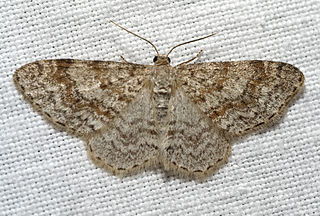
Larentiinae is a subfamily of moths containing roughly 5,800 species that occur mostly in the temperate regions of the world. They are generally considered a subfamily of the geometer moth family (Geometridae) and are divided into a few large or good-sized tribes, and numerous very small or even monotypic ones which might not always be valid. Well-known members are the "pug moths" of the Eupitheciini and the "carpets", mainly of the Cidariini and Xanthorhoini. The subfamily was described by Philogène Auguste Joseph Duponchel in 1845.

Didymoctenia is a monotypic moth genus in the family Geometridae and subfamily Ennominae which was described by Warren in 1901. Its only species, Didymoctenia exsuperata, the thick-lined bark moth, was first described by Francis Walker in 1860. It is found in Australia.
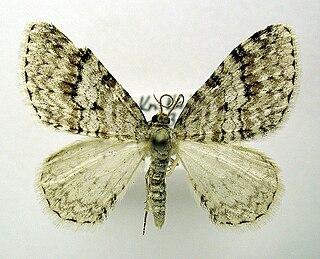
Venusia is a genus of moths in the family Geometridae erected by John Curtis in 1839.

Melanolophia imitata, the western carpet or green-striped forest looper, is a moth of the family Geometridae. The species was first described by Francis Walker in 1860. It is found in western North America from southern California, north to Alaska and east to extreme south-western Alberta.

Venusia cambrica, the Welsh wave, is a moth of the family Geometridae. It is found in Europe, western and central Siberia, Altai, Transbaikalia, the Russian Far East, the Korean Peninsula, Japan and in North America, where it can be found across Canada from Newfoundland and Labrador to British Columbia, south in the west to California, south in the east to Georgia.

Asthenini is a tribe of geometer moths under subfamily Larentiinae first described by Warren in 1893. The tribe has been combined with Eupitheciini in the past, most notably by Jeremy Daniel Holloway in his work The Moths of Borneo.
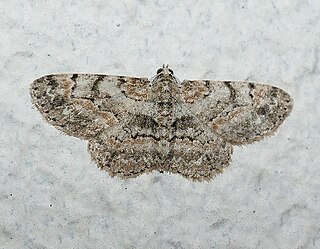
Iridopsis ephyraria, commonly known as the pale-winged gray, is a species of moth in the family Geometridae. The species was first described by Francis Walker in 1860. It is found in the United States and southern Canada east of the Rocky Mountains, from New Brunswick to Florida, west to Texas and north to Alberta.

Fascellina chromataria is a moth in the family Geometridae described by Francis Walker in 1860. It is found in Korea, Japan, Taiwan, China, India, Bhutan and Sri Lanka.

Hydrelia albifera, the fragile white carpet moth, is a moth in the family Geometridae. The species was first described by Francis Walker in 1866. It is found from Newfoundland to British Columbia, south in the east to the Gulf states. The habitat consists of deciduous and mixed-wood forests.
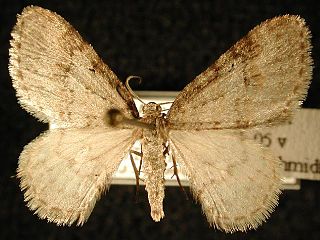
Venusia pearsalli, or Pearsall's carpet moth, is a moth in the family Geometridae. The species was first described by Harrison Gray Dyar Jr. in 1906. It is found in western North America, from Alaska, Alberta and British Columbia, through Washington and Oregon to California.

Nomenia duodecimlineata is a moth in the family Geometridae first described by Alpheus Spring Packard in 1873. It is found in western North America, from British Columbia to California, Nevada, Arizona and New Mexico.
Nomenia obsoleta is a moth in the family Geometridae first described by Louis W. Swett in 1916. It is found in western North America, from British Columbia, through Washington and Oregon to California.
Venusia megaspilata is a moth in the family Geometridae first described by William Warren in 1895. It is found in Japan and Korea.

Hydriomena divisaria, the black-dashed hydriomena moth, is a moth in the family Geometridae. It is found in North America, where it has been recorded from southern Canada and the northern United States, south to Georgia in the east.

Hyposidra talaca, the black looper or black inch worm, is a moth of the family Geometridae. The species was first described by Francis Walker in 1860. It is found from India to Indochina, Sundaland, Sulawesi, the Philippines, Sri Lanka, the Solomon Islands, Thailand, Taiwan, New Guinea and Australia, where it has been recorded from Queensland. It is a major defoliating pest in tea plantations.
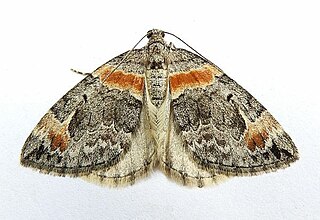
Dysstroma hersiliata, the orange-barred carpet moth, is a species of geometrid moth in the family Geometridae. It is found in North America.
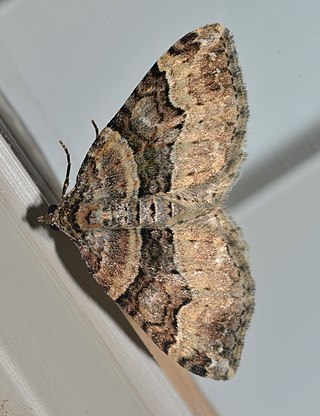
Xanthorhoe lacustrata, the toothed brown carpet moth, is a species of geometrid moth in the family Geometridae. It is found in North America.
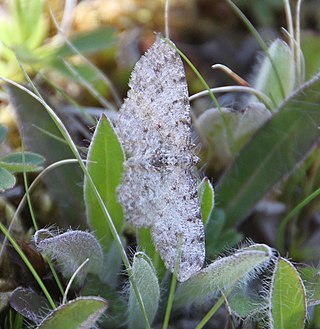
Aethalura intertexta, the four-barred gray or smoky carpet moth, is a moth in the family Geometridae. The species was first described by Francis Walker in 1860. It is found in North America.
















